Oppo Reno 10x zoom detailed review
If display technology is something we give Samsung the credit for, then Oppo should be the one to be credited for the beautiful-looking phones that are all the rage right now. The company spearheaded the pop-up camera trend last year with the Oppo Find X. Vivo too was part of it, but Oppo launched few, but classy-looking phones with bezel-less displays and a mechanical camera. With its own innovation now diluted amidst major OEMs, the company then came out with the Oppo Reno 10X Zoom, replete with a design makeover not just of the device but also the logo, packaging and the other branding. The Oppo Reno 10X Zoom certainly looks classy, has the necessary firepower inside to claim flagship status and offers a periscope camera with 10X hybrid zoom. That feature is literally part of the phone’s name!
The Reno 10X Zoom looks and feels like a flagship phone and has the OnePlus 7 and the OnePlus 7 Pro for company in the high-end segment. With a starting price of Rs 39,990 for the base variant, the Oppo Reno 10X stops just short of falling in the premium-flagship category, but with formidable features like a Snapdragon 855 SoC, periscope camera and a premium design, can the Oppo Reno 10X Zoom prove its worth? Let’s find out.
Design
The Oppo Reno 10X Zoom is one of the classiest looking phones to come out this year. The OnePlus 7 Pro would be another and there’s of course the premium flagships which have no choice but to look good. For Rs 39,990 though, you get a frosted-glass design that both looks and feels premium. We received the ocean green colour variant of the phone and it’s by far one of my favourite phones to use. It has a seamless body. It has a triple-camera setup that’s flushed to the body. No ugly camera bump or a fingerprint sensor on the body. There’s a both “Designed by Oppo” and the “Oppo” logo housed in a vertical strip that runs along the center. The top end of the strip houses a small dot that keeps the camera from touching the surface when the phone is placed flat.
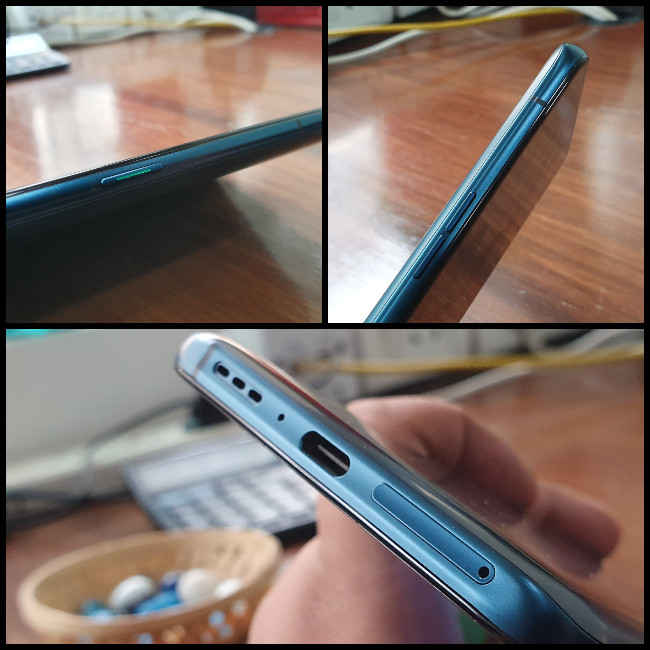
On the front is all glass, almost bezel-less save for some at the bottom which is minimal. It’s also quite wide and expansive and stretches all the way to the edges without any interruption. The volume rockers on the left and the power button is on the right, both quite easy to reach, but they do feel a little stiff. The speaker grille on the bottom along with the USB-C port and the SIM tray. Quite expectedly, the Oppo Reno 10X Zoom doesn’t come with a 3.5mm headphone jack. You can’t really call yourself a courageous flagship without ditching the legacy port now, can you?
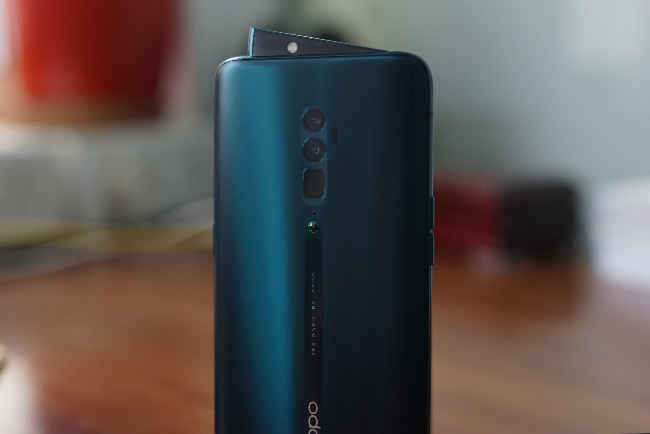
My favourite aspect of the phone’s design, however is something that’s hidden from plain sight. The Reno 10X Zoom has a different take on the pop-up camera design. Instead of making it a pole-like structure that pops out of the body, the Reno’s front camera is housed in a shark-fin shaped structure. There’s nothing special about it save for the fact that it looks different, and in a market as competitive as this, that’s what counts these days. Nevertheless, the shark-fin camera rises from the top edge when you unlock the phone or when you’re clicking a selfie, or when you need to use the flash. The module takes less than a second to come up, but after using the phone for more than a week, the module has become quite noisy. It’s something that we have noticed in most pop-up camera phones. After prolonged used, the module slows down and becomes noisy and there’s no guarantee the Reno’s shark-fin module will follow the same path. There’s also a question of durability. The module does close when a drop is detected to prevent damage to the camera, but I did have the module rise up accidentally once in my pocket, looking for a face to detect.
While the Reno 10X Zoom does look classy and premium, it’s quite bulky. The phone weighs 210 grams which is much higher than the average weight of smartphones, and most of the weight is distributed around the camera making it top heavy. As a result, it’s gives a good grip when held in landscape mode, but when used one-handed, the weight does become bothersome after a point.
Display
The Oppo Reno 10X Zoom’s display takes up the entire front fascia. It’s a wide and expansive display stretching 6.6-inches diagonally. It’s protected by Gorilla Glass 6 and there’s practically no bezels around the panel and it does give an immersive experience when playing games or watching movies. The display on the Reno 10X is an AMOLED panel with full HD+ resolution and 100 percent DCI-P3 coverage. Despite the full spectrum of DCI-P3 colour profile available, the display is still not HDR certified, which is quite strange. Also, DCI-P3 is only engaged when you choose the Vivid colour profile in the display settings. If you choose Gentle mode, the colour space will be sRGB.

The Reno 10x Zoom’s display is quite good. It clocked an impressive 765 lux in our brightness test, but when compared against the display of the Galaxy S10, the panel seemed to have a cooler bias. There is a tendency to boost the blues while the reds and greens come out a little faded. The S10’s display also felt much more dynamic and vibrant as compared to the Reno.
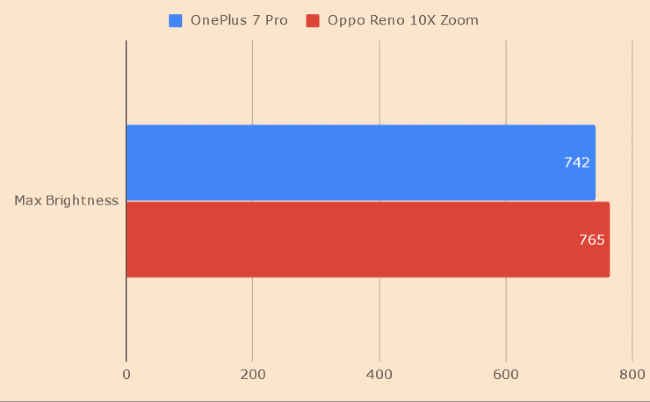
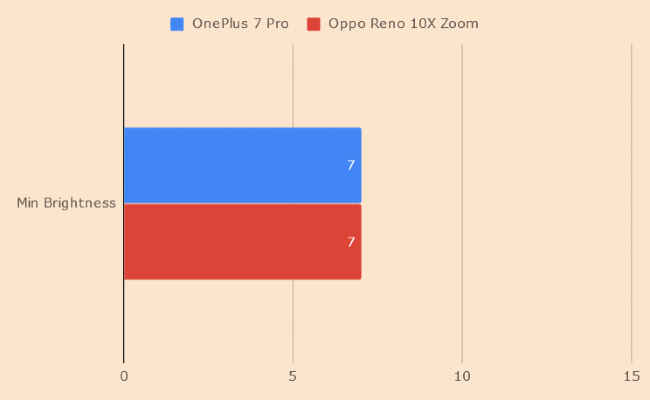
The phone’s minimum brightness, however was quite high,as compared to other AMOLED displays. With a 7 lux readout, the Reno is especially uncomfortable to use at pitch darkness. It’s bright enough to affect the eyes at night. However, it’s perfectly comfortable to use under direct sunlight.
The Reno’s display also integrates an in-display fingerprint sensor which is just as fast as the OnePlus 7 Pro. Both of them use the same sensor module and with some software-level tweaks, the sensor feels almost as fast as the physical ones. There are times when the authentication failed, but eight out of ten times it will work.
Performance and software
The Oppo Reno 10X Zoom is no slouch. It’s powered by the Snapdragon 855 processor and comes with up to 8GB RAM and 256GB storage. That’s plenty of resources to handle almost everything you throw at the phone. Despite the hardware, the Oppo Reno 10X Zoom is not aimed at enthusiasts and gamers like the OnePlus 7 Pro or the Black Shark 2. Still, with similar hardware, the performance of the Reno 10X Zoom is comparable to the crop of flagship phones that launched this year.
CPU Performance
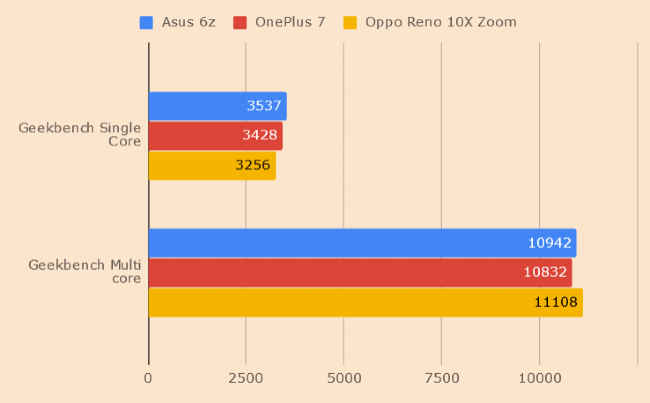
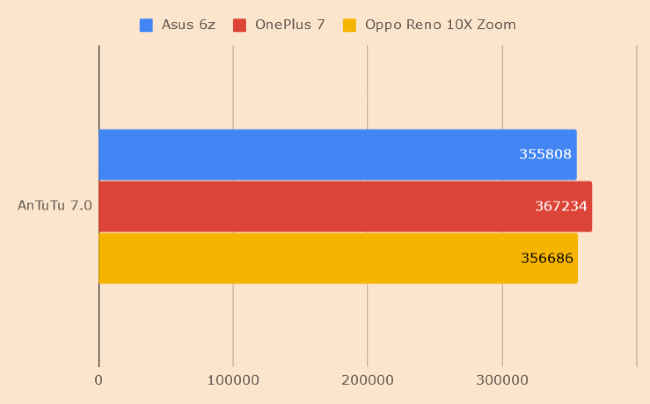
On AnTuTu, the Reno 10X Zoom scored 356686, slightly lower than the OnePlus 7 Pro’s 368084 which is actually the highest AnTuTu score we have recorded on an Android phone yet. On Geekbench Single and Multi-core tests, the Reno scored 3256 and 11108 respectively. In comparison, the OnePlus 7 Pro scored higher in single-core test but lower on the multi-core test. Furthermore, Mobile Xprt 2015 scores show that the Reno is slightly slower than the OnePlus 7 Pro.
The Oppo Reno’s ColorOS 6 also doesn’t really kill apps in the background. Instead, it puts apps in freeze mode so that when you switch back to the app, you instantly start off from where you left off. That does lead to high resources consumption. We received the 8GB RAM variant for review and more often than not, at least 60 percent of the memory was always under consumption. While gaming, free RAM would range around 30 to 35 percent, which is a good thing.
Gaming Performance

The Adreno 640 GPU in the Snapdragon 855 that powers the Oppo Reno 10X Zoom is the best GPU Qualcomm has to offer. That also resulted in the best 3DMark Sling Shot score we have seen on an Android device. With 7550 points, it’s even higher than the OnePlus 7 Pro’s score for the same benchmark. The dominance is further confirmed by the GFXBench numbers where the Reno scores higher than the OnePlus 7 Pro.
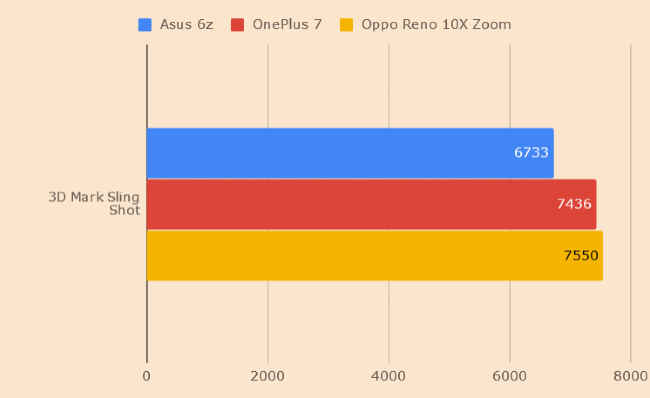
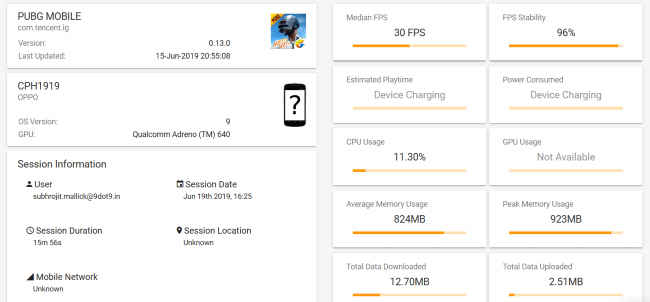
Courtesy Gamebench
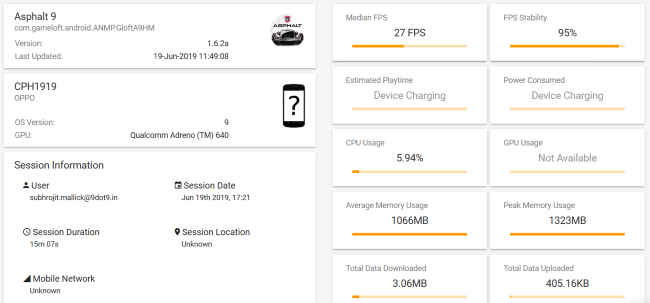
Courtesy Gamebench
The Oppo Reno 10X Zoom delivers good performance in gaming. Games like PUBG Mobile, Asphalt 9, DragonBall Legends, and Real Racing 3 worked without a hitch. The gigantic screen also helps making games feel more immersive. On PUBG Mobile, the Reno hit 30 FPS with 96 percent stability while on Asphalt 9, the Oppo Reno hit 27 FPS with 95 percent stability. Both these numbers were calculated using GameBench where the OnePlus 7 Pro also gave similar numbers.
The Oppo Reno 10X Zoom comes with Oppo’s own GameSpace which, when turned on, kills all the background apps to free resources, juggles the internet connection between Wi-Fi and 4G and mutes notifications. There are three modes to choose from, for each game -- Low Power Consumption Mode, Balanced, and Competitive Mode. The Game Space mode also displays the battery life left, but there’s little options to tweak around. Most of it is automated and there’s not really much to confidently say there’s a definite boost in gaming performance.
Software
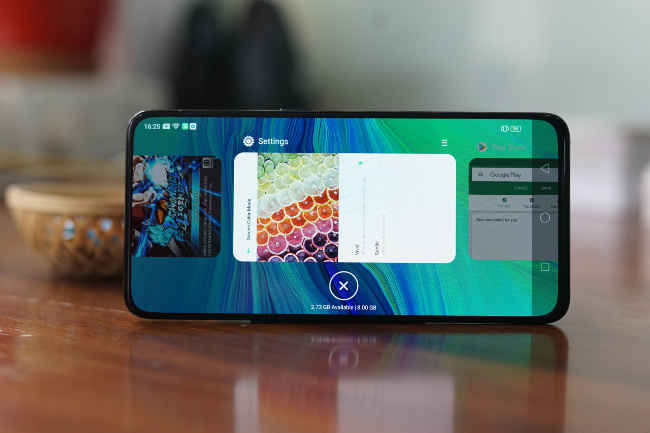
The ColorOS 6 that powers the Oppo Reno’s user experience is the best UI Oppo has created so far. It’s based on Android 9 Pie and there’s a remarkable improvement in UI aesthetics. Simple things like the Settings Gear icon now look more minimalistic and there’s an app drawer included. Things that are good in the UI is the inclusion of an app drawer and a more seamless transition animation and aesthetics. The UI is also packed with interesting features like a theme engine, driving assistant and the likes. There’s also a fair bit of customisation available including tweaking the animation speed, enabling smart services and more.
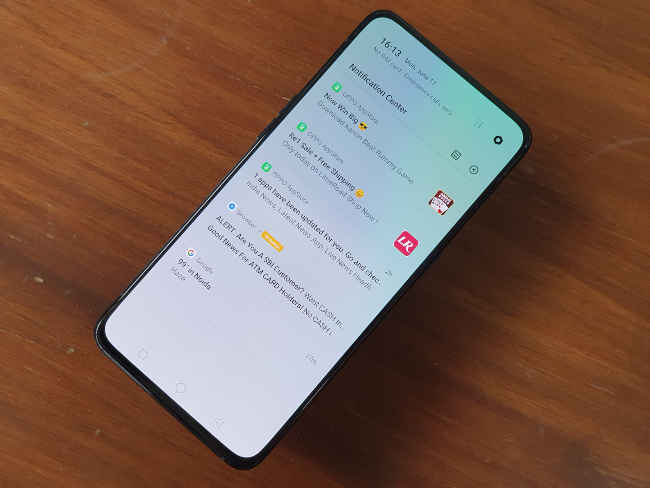
What a cluttered notification shade looks like
What’s annoying in the UI is the horde of bloatware apps, some of which can’t be installed and some quite invasive. For instance, Daily Hunt floods the notification panels with mindless news headlines even without using the app. Thankfully that can be removed. But apps like the Oppo App Store, and the native browser keep pushing notifications throughout the day which keeps the notification shade cluttered all the time.
Thankfully, there’s a way to stop the onslaught of notifications. You can manually disable or freeze the apps that keep pushing mindless notifications from the App settings, but it’s a tedious process that will take a good ten-fifteen minutes to finish.
Camera
The camera on the Oppo Reno 10X Zoom is why Oppo wants you to buy this phone. It’s using a new technology that relies on a periscope setup to achieve 10X hybrid zoom. Oppo did show-off the tech a few years back at MWC 2017 but it’s only now that the tech is showing up. Furthermore, the Reno is not the only phone with a 10X zoom achieved using a periscope telephoto lens. The Huawei P30 Pro also uses a similar setup and offers 10X hybrid and a whopping 50X digital zoom. The Reno also goes to 60X digitally, but it’s hardly of any use. We did a comparison against the P30 Pro’s zoom and found that the Reno was almost as good as the P30 Pro in terms of preserving details when zoomed in at 10X.

The Reno 10X Zoom’s camera stack comprises of a 48MP Sony IMX586 sensor with f/1.7 aperture, an 8MP ultrawide camera with f/2.2 aperture and a periscope 13MP camera with f/3.0 aperture. It’s the third lens in the stack that’s quite different from other telephoto lenses found in mobiles. This one has a prism that bends the light entering the telephoto lens to achieve higher magnification with little loss in detail. In addition, instead of stabilising the lenses while shooting, Oppo keeps the prism steady so that there’s less shake while zooming in. But that doesn’t really work as good as the OIS on P30 Pro as it was quite difficult to maintain stability at 10X zoom.

Shot on the 48MP primary camera
Nevertheless, photos in the day with the 48MP sony sensor, come out really nice. The colours may look a little too saturated but the photos come out noise-free with high sharpness, and can be called flagship worthy. The default output is in 12MP but you can flick the 48MP mode to take high-resolution photos. However, while the 48MP photos allow you to crop the frame better, the details are sharper in the 12MP binned image.

Shot on the wide-angle camera
The wide-angle camera, on the other hand is the weakest link in the camera stack. It may handle daylight photos just fine, but noise starts popping up when the sun goes down. Oppo does give the option to focus in the wide-angle camera which is not there on the Galaxy S10, but it’s performance is nowhere close to the S10+ or the P30 Pro, especially at low light.

10x zoom in daylight

10x zoom in lowlight
Now, the prism telephoto lens which is the star of the show apparently has 13MP resolution but outputs only in 12MP. Furthermore, the effective zoom from the primary 48MP sensor to the telephoto is 5X and not 10X as advertised. The 10X zoom is calculated from the focal length of the wide-angle camera. If you calculate the zoom from the primary camera, the effective optical zoom is 5X. However, you won’t find a 5X zoom option. The camera directly goes from 2X to 6X and then to 10X. Getting to 5X means fiddling around with the zoom dial which is annoying.

10x zoom achieved using Huawei P30 Pro
 '
'
10x zoom achieved using Oppo Reno
As for the quality of zoom itself, it’s perfectly comparable to the P30 Pro. The Reno is able to reproduce almost the same amount of detail, but the P30 Pro edges it out in colours, contrast and dynamic range. However, the image quality of both the devices at 10X zoom is nowhere close to the quality the primary cameras on both phones deliver. Having said that, it’s quite remarkable how technology has advanced so far that we can get 10X zoom without having to increase the thickness of the phone to that of a DSLR camera.
The Oppo Reno 10X Zoom’s camera is good for taking landscape shots where the camera is tuned to produce excellent details with a good dynamic range. Indoor and food photos too come out quite good, although with less-than-optimum lighting, the camera will struggle to keep the right exposure and sharpness. In this case, the Night mode in the Reno 10X Zoom does good work. It takes multiple shots and fuses them to create a well-lit photo. Of course you won’t be able to use the feature to shoot moving objects like pets, cars and the likes. Thanks to the wide-angle camera, you can also go quite close to the subject without losing focus. The primary 48MP camera can’t go macro close, but thanks to the auto-focus motor in the wide-angle camera, it also doubles up as a good macro lens.

The Oppo Reno also houses a shark-fin camera with 16MP resolution that pops out at an angle. The 16MP camera on the front comes with the usual bells and whistles you would expect from a selfie camera on an Oppo flagship. By that, we mean a jacked up beauty mode that hides every spots and blemishes from your face. With the beauty mode turned off though, it is quite good though with less highlight clipping and good facial details.
Battery
The Oppo Reno 10X Zoom comes with a 4,065mAh battery that tops up with a 20W VOOC charger. What that means is that while the large battery ensures the phone lasts well over a day, topping it up to max capacity only takes a little more than an hour. On Geekbench’s Battery Test, we clocked over 12 hours of screen-on time, which is pretty impressive and seen mostly in mid-range phones these days and not on flagships much. However, this screen-on time might not reflect real world battery stats. We noticed a large a drop from 67 percent to 51 percent after running Google Maps navigation for 40 minutes while 30 minutes of Netflix drained the battery by 8 percent while 15 minutes of PUBG Mobile drained the battery by 4 percent. The Reno 10X Zoom certainly has a good battery life provided that can extend over a day with moderate usage.
Conclusion
The Oppo Reno 10x Zoom is perhaps the best designed phone to launch this year. It feels classy and sturdy at the same time. It looks the part of a flagship, all right, but it also performs the part of a flagship really well. The performance of the phone is pretty flawless with little to no lag in loading apps, playing games and the likes. The display spans across the entire body making it feel really immersive. A major downside we found was the UI and the plethora of bloatware that clutter the notification shade in no time. The Reno 10X Zoom’s camera is the star of the show, however. The photos in the day are comparable to a premium flagship while the low-light performance needs a little more polish. Buy the Reno 10X Zoom if you are looking for a sturdy, well-designed high-end phone with a good camera and performance. However, with a QHD+ display and 90Hz refresh rate along with a UI that’s perhaps the most efficient, the OnePlus 7 Pro is a more sensible purchase in that price range even if the Reno beats the OnePlus by a small margin in most of the synthetic benchmarks.
[ad_2]
Source link

Post a Comment